



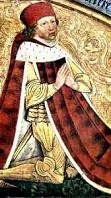
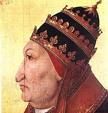


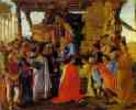

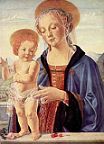


1470 Between this year and 1700, a total of 8,888 witches are tried in the Swiss Confederation, and 5,417 executed. On Mar. 12 after English king (since 1461) Edward IV, 4th Duke of York (1442-83) declares his cousin, kingmaker Richard Neville, 6th Earl of Salisbury and 15th Earl of Warwick (1428-71) a traitor, and gets some of the Lancastrians to switch sides, he defeats him and his turncoat brother George Plantagenet, 1st Duke of Clarence, 1st Earl of Salisbury, 1st Earl of Warwick (1449-78) at the Battle of Empingham (Lose-Coat Field); kingmaker and Clarence flee to France and make up with exiled Queen Margaret at Louis XI's urging, then stir up a Lancastrian revolt, and return to England in Sept. and defeat Edward IV on Sept. 13 at the Battle of ?, and Edward IV flees to Burgundy to seek help from his brother-in-law Charles the Bold (Shakespeare claims that kingmaker sneaks into Edward IV's camp and captures him, thus avoiding a bloody battle, then turns him over to his brother George Neville, archbishop of York for safekeeping, but the latter keeps him under too light a guard, allowing Edward's youngest brother, crippled Richard of Plantagenet, duke of Gloucester to free him); kingmaker has weak-minded Henry VI freed from the Tower, returning to power on Oct. 9 after kingmaker proclaims him king, which is how he gets the name kingmaker, duh?; Henry VI now reigns while kingmaker rules for the next 6 mo., making his side-switching younger brother George Neville (1432-76), archbishop of York (1465-76) (chancellor in 1460-7) (who took an oath of allegiance to Edward IV) chancellor of England again (until 1471); the exiled Yorkist kingy-queeny having nothing else to do in Burgundy, they have son Edward V on Nov. 1; on Dec. 13 Henry VI's pride-and-joy son and heir Edward of Lancaster, Prince of Wales (1453-71) is married to kingmaker's daughter Anne Neville (1456-85), causing the duke of Clarence to finally see the light and switch sides back to his brother Edward IV? - I had to get back to me? On July 12 the Ottomans under Mehmed II the Conqueror take the city of Negroponte (Chalkis) on Euboea Island, the main Venetian naval base in the Aegean Sea. Swedish king Carl VIII Knutsson dies, and Sten Sture the Elder (1440-1503) (a distant kinsman of the later Sten Sture the Younger) takes charge as regent (until 1497, then 1501-3), gaining the support of Stockholm and the other towns, promising the reforms of Engelbrecht and working to get the crown; Christian I of Denmark sees his chance, and invades with 70 ships and 3K men, and on Oct. 10 the Battle of Brunkeberg outside Scotland, results in a bad defeat, causing him to resort to peace talks which promise his reinstatement as king of Sweden, but never deliver, Sten Sture being elected regent by the Swedish nat. assembly. Hohenzollern Brandenburg elector #2 (since 1440) Frederick II (b. 1413) abdicates in favor of his younger brother Albert (Albrecht) Achilles, who becomes Albert III (1414-86) (until Mar. 11, 1486). Ivan III of Moscow launches a war against the repub. of Novgorod (ends 1478). Pope Paul II changes the Jubilee Period from 50 to 25 years - is that like giving yourself a pay raise? Rodrigo Borgia (1431-1503) (future Pope Alexander VI) meets hot Roman lady Vannozza (Giovanna) dei Catanei (1442-1518), who go on to have some little rugrats, incl. the supermodel of the cent. Lucrezia Borgia (b. 1480). The Incas capture Quito, and dominate Ecuador-Bolivia until 1532. Princess Juana of Portugal popularizes the farthingale wide-hipped skirt - in the days before Weight Watchers? The first printed book in France is made for the umpteenth-grandson of Charlemagne on the first French printing press, set up at the Sorbonne in Paris. Chancery Standard comes into vogue in London, launching Early Modern English (ends 1550). Sports: Compulsory archery practice is renewed in England, with hazel, ash, and laburnum wood allowed for practice bows because of the yew wood shortage. Architecture: The Mosque of Mehmed II the Conqueror (begun 1463) in Constantinople is finished. The Gothic-style Stiftskirche in Stuttgart, Germany is built by Peter von Koblenz. Art: Sandro Botticelli (1445-1510), Adoration of the Magi (1470-5). Carlo Crivelli (1430-95), St. George and the Dragon. Sano di Pietro (1406-81), The Massacre of the Innocents. Ercole de'Roberti, St. Jerome in the Wilderness. Martin Schongauer (1448-91), The Man of Sorrows (copper engraving); one of the first German painters to work extensively as an engraver, influencing Albrecht Durer et al. Andrea del Verrocchio (1436-88), Madonna and Child. Plays: Anon., Apu Ollantay; Peruvian Incan drama; recorded in 1770 by Dr. Valez in Cuba. Poetry: Anon., Maitre Pathelin; the first French farce about lawyer Maitre Pathelin and his wife Guillemette; coins the term "patheliner", meaning to malinger. Births: Italian scholar-poet and cardinal (1539-) Pietro Bembo (d. 1547) on May 20 in Venice; creator of the classic Petrarch-imitating style known as bembism. French Valois king (1483-98) Charles VIII (the Affable) (d. 1498) on June 30 in Amboise; only surviving son of Louis XI (1423-83) and 2nd wife Charlotte of Savoy (1443-83); one of his feet has six toes, causing him to wear square-toed shoes. Chinese Ming emperor #9 (1487-1505) Hongzhi ("great government") (Zhu Youcheng) (d. 1505) on Juy 30; son of Chenghua (1447-87); husband of empress Xiaochengjing. English smothered king (1483) Edward V (d. 1483) on Nov. 2 in Westminster Abbey, London; eldest son of Edward IV (1442-83) and Elizabeth Woodville (1437-92); brother of Richard of Shrewsbury, duke of York (1473-83). Dutch humanist Jeroen van Busleyden (Hieronymus Buslidius) (d. 1517) in Arlon; friend of Erasmus. Italian humanist scholar-grammarian Cosentius (Aulo Giano Parrasio) (Aulus Janus Parrhasius) (d. 1522) in Cosenza, Calabria. German humanist Willibald Pirckheimer (d. 1530) on Dec. 5 in Eichstatt. Moldavian prince (1504-17) Bogdan III the One-Eyed (d. 1517 in Husi; son of Stefan cel Mare and Doamna Maria Voichita. Italian poet and cardinal Bernardo Dovizi da Bibbiena (d. 1520). German cartographer (coiner of the term America) Martin Waldseemuller (Waldseemüller) (d. 1520). in Wolfenweiler; educated at the U. of Freiburg. Chinese artist Tang Yin (d. 1523). German physician Eucharius Rosslin (Rösslin) (d. 1526) in Freiburg?; father of Eucharius Rossling the Younger. Spanish adventurer Panfilo de Narvaez (Pánfilo de Narváez) (d. 1528). Lithuanian marshal prince (Roman Catholic) Michael (Mikhail) Lvovich Glinski (Glinsky) (d. 1534); of Tartar extraction; mother is daughter of Ruthenian noble Ivan Esmanovich, a Jewish convert to Orthodox Christianity; uncle of Ivan the Terrible. Portuguese poet-actor ("the Troubadour") ("Founder of Portuguese Drama") Gil Vicente (d. 1536) in Lisbon; known for his autos (religious mysteries). Portuguese explorer Pedro Mascarenhas (d. 1555). Italian monk Maxim Grek (Maxim the Greek) (Michael Trivolis) (d. 1556); educated in Florence; converts to Orthodox Greek and settles in Mt. Athos, then Russia. English Tudor historian Polydore Vergil (Castellensis) (d. 1557) in Urbino, Italy; educated at the U. of Bologna. Deaths: Spanish poet Alfonso Martinez de Toledo (b. 1398). Italian painter Jacopo (Iacopo) Bellini (b. 1400). Hindu sage Ramananda (b. 1400). Muslim Mamluk scholar Abu al-Mahasin Yusuf ibn Taghribirdi (b. 1411).
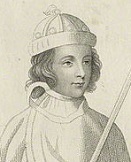
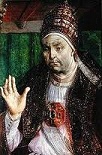




1471 On Mar. 14 after gaining Burgundian aid, Edward IV of England and his brother Duke Richard of Gloucester (future Richard III) return from the Netherlands, joining their prodigal brother Duke George of Clarence; on Apr. 14 (Easter Sun.) the Battle of Barnet is a big V for Edward IV's Yorkists against Henry VI's Lancastrians, led by Richard Neville, 15th earl of Warwick (b. 1428), who is KIA along with his brother John Neville, earl of Northumberland after the heavy fog confuses his own troops and they attack each other; archbishop George Neville switches to the winning side again and turns Henry VI and himself in, and they are imprisoned together in the Tower of London, after which George is soon pardoned, then arrested again for treason next Apr. 25, and imprisoned in Hammes Castle near Calais until Nov. 1474, a broken man, croaking on June 8, 1476; pissed-off Queen Margaret then brings in an army from France led by Edmund Beaufort, 4th Duke of Somerset (b. 1438), but on May 4 Edward IV's Yorkists bury her French tewk at the Battle of Tewkesbury in Gloucester in a battle of Prince Edward vs. King Edward; Margaret is captured, and her 18-y.-o. great white hope son Edward of Lancaster, Prince of Wales (1453-71) is butchered (by all three sons of York, according to Shakespeare), becoming the first (only?) prince of Wales to die in battle; on May 6 the duke of Somerset and other Lancastrian nobes are beheaded after a trial presided over by Edward IV's brother Duke Richard of Gloucester, who is also constable of England; on May 21 Henry VI (b. 1421) is killed in the Tower of London with a heavy blow to the back of the head, causing his hair to mat against his skull; the Lancastrian line is ended, the male line of the Beauforts is extinct, and the only remaining rep. of the Lancastrian claim is 14-y.-o. Henry Tudor, earl of Richmond (future Henry VII) (son of Margaret Beaufort, a direct descendant of John of Gaunt), who flees to Brittany; the remoteness of his claim allows Edward IV to feel safe from another Lancastrian revolt, and the rest of his reign is popular and peaceful. On July 26 Pope (since 1464) Paul II (b. 1417) dies, and on Aug. 9 Francesco della Rovere is elected Pope (#212) Sixtus IV (1414-84), the first of six grossly immoral popes (6-4/5/6?) whose escapades trigger the Protestant Reformation; he fathers six illegitimate sons, one with his sister, and later unleashes the Spanish Inquisition; he issues a bull banning nosepicking under pain of eternal damnation, and goes on to try to make the papacy a family business. On Aug. 22 after King George of Bohemia dies, and the widow of George Podebrady nominates him, 15-y.-o. Vladislav (Ladislas) (Uladislaus) II Jagiello (1456-1516), son of Casimir IV of Poland is elected king of Bohemia, becoming dominated by his advisors, who help him fight the challenge of Matthias Corvinus (ends 1479). On Dec. 21 Portuguese explorers Joao de Santarem (Santarém) and Pedro (Pero) Escolar discover Mina (Elmina) (S coast of South Ghana 7.5 mi. W of Cape Coast) on the Gold Coast in West Africa, stretching from Cape Three Points to the Volta (Port. for bending or turning) River, and set up a trading station, becoming the first Euro settlement in West Africa; they go on to discover Annobon next Jan. 1 and Principe on Jan. 17, 1472. Austria gains the seaport of Fiume (Rijeka) in Yugoslavia (until 1779). Borso d'Este is granted the title of Duke of Ferrara from Pope Paul II. Sten Sture the Younger expels Christian I of Denmark from Sweden. James III of Scotland proposes an expedition of 60K men to invade Brittany, annex Gueldres, then acquire Saintonage from the French, but the plans are scrapped when his subjects balk at the expense. The Portuguese capture Tangiers. The armies of the Vietnamese Le Dynasty under Emperor Le Thanh-Tong conquer the kingdom of Champa in N Vietnam (founded in 2nd cent. C.E.). Queen (since 1454) Shin Sawbu (b. 1394) dies, and her ex-Buddhist monk son-in-law Dhammazedi (1409-92) becomes Hanthawaddy king #16 of Burma (until 1492), becoming the greatest Burmese king, enjoying a peaceful reign during which his kingdom becomes a center of Theravada Buddhism, with strong ties to Ceylon, sending missionaries throughout Burma. The Worshipful Co. of Dyers in England is founded, sharing with the Worshipful Co. of Vinters the right to keep swans in the Thames River and participate in swan-upping. Science: German astronomer Regiomontanus (Johannes Muller von Konigsberg) (Johannes Müller von Königsberg) (1436-76), pupil of Austrian astronomer Georg von Puerbach (Purbach) (1423-61) sets up the Nuremberg Observatory, becoming the first European observatory. Nonfiction: Marsilio Ficino (tr.), Corpus Hermeticum. The first complete Bible in Italian, by Camaldolese monk Niccolo Malerbi (Malermi) (1422-81) is printed in Venice after spending only 8 mo. doing the trans. work, becoming the first printed Bible in Italian to achieve significant circulation. Art: Pinturicchio (1454-1513), The Crucifixion with St. Jerome and St. Christopher. Music: Jacob Obrecht (1450-1505), St. Matthew Passion. Births: German "Praying Hands", "Knight, Death and the Devil" #1 painter-engraver Albrecht Durer (Dürer) (d. 1528) on May 21 in Nuremberg; father is a goldsmith; studies under German painter Michel Wohlgemuth; friend of Erasmus and Melanchthon. German Catholic Saxon duke (1500-39) George the Bearded (d. 1539) on Aug. 27 in Meissen; eldest son of Duke Albert (1443-1500) and Sidonie Podiebrad; brother of Henry IV the Pious (1473-1541); known for his excellent education for a prince; member of the Order of the Golden Fleece. Danish-Norwegian-Swedish king (1426-81) Frederick I (d. 1533) on Oct. 7 in Haderslevhus; son of Christian I and Dorothea of Brandenburg (1430-95). Spanish explorer (conqueror of the Incas) Francisco Pizarro Gonzalez, 1st Marques de los Atabillos (d. 1541) in Trujillo, Extremadura; illegitimate son of Gonzalo Pizarro Rodriguez de Aguilar Sr. (1446-1522) and Francisca Gonzalez Mateos of Trujillo. Italian Renaissance painter Gaudenzio Ferrari (d. 1546) in Valduggia, Piedmont; pupil of Girolamo Giovenone and Stefano Scotto; #1 master of the Lombard School; known for his heads and draperies. Deaths: German mystic Thomas a Kempis (b. 1380) on July 25 in Zwolle, Utrecht. Portuguese explorer Joao Goncalves Zarco (b. 1390) on Nov. 21 in Funchal. Italian scholar Antonio Beccadelli (b. 1394) in Jan. in Naples; leaves The Sayings and Deeds of King Alfonso V of Aragon. Czech Hussite theologian John of Rokycany (b. 1396) on Feb. 21 in Prague. German elector (1440-70) of Brandenburg Frederick II (b. 1413) on Feb. 10 in Neustadt an der Aisch. Japanese emperor #102 (1428-64) Go-Hanazono (b. 1419) on Jan. 18. English king (1421-71) Henry VI (b. 1421) on May 21 in the Tower of London (murdered). English kingmaker Richard Neville, 15th Earl of Warwick (b. 1428) on Apr. 14 (KIA at the Battle of Barnet). English prince of Wales Edward of Lancaster (b. 1453) on May 4 in Tewkesbury (KIA). Indian ruler #9 (1438-71) Pachacutec (b. ?). English kingmaker's brother John Neville, earl of Northumberland (b. ?) on Apr. 14 (KIA at the Battle of Barnet).

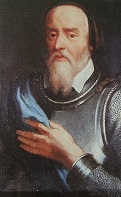

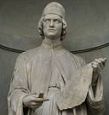
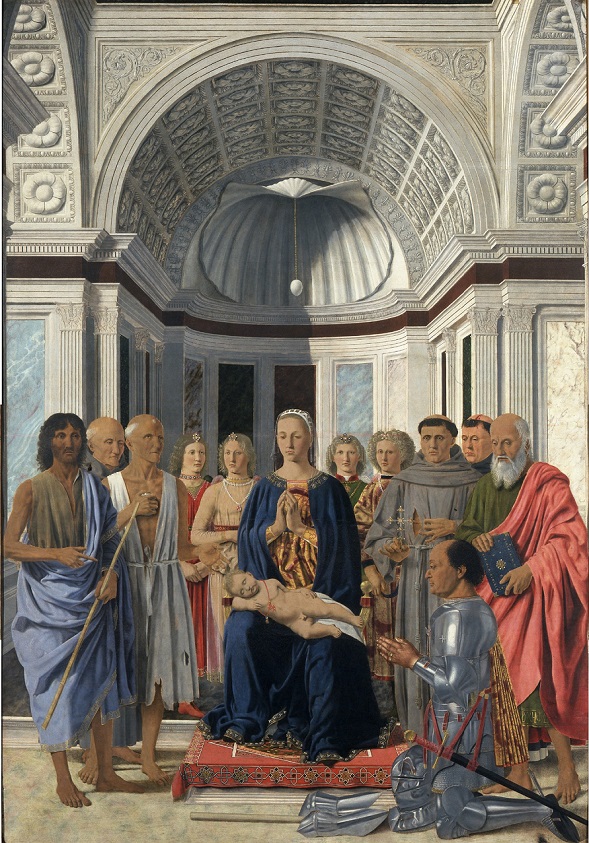

1472 In Apr. Duke Richard of Gloucester marries Anne Neville, widow of Edward, prince of Wales and daughter of the super-rich but dead earl of Warwick, whose remaining property now goes to the royal house; meanwhile Margaret Beaufort marries Thomas, Lord Stanley, the king's councillor and steward of the household. On Aug. 17 Pope Sixtus IV issues a bull raising St. Andrews in Scotland to the status of an archbishopric with metropolitan authority over the other 12 Scottish bishops in an effort to counter the efforts of James III to limit papal control over finances, but the plan backfires as the Scottish bishops turn on archbishop Patrick Graham and he is sacked in 1478 after the pope abandons him. Russian grand prince (since 1462) Ivan III of Moscow marries Sophia Palaeologus, niece of late Byzantine emperor Constantine XI Palaeologus (who fell in 1453 on the walls of Constantinople), establishing himself as the protector of the Orthodox Christian Church, adding the double-headed eagle of the ancient Roman, Byzantine, and Holy Roman emperors to his personal coat of arms, and proceeding to set himself up as tsar (czar) (caesar) (although he doesn't officially call himself that?), with a regime modeled on the autocratic Byzantines with its own Russian code of law, drastically curtailing the Russian aristocrats, who have to kiss his hiney and call him Ivan III the Great; meanwhile after being put up to it by Ivan's enemy grand duke Casimir IV of Lithuania, Akhmat, khan of the Golden Horde attacks Ivan's principality and destroys the city of Aleksin. The Eastern Orthodox Church repudiates the 1438 Council of Florence, finalizing the Great Schism with the Roman Catholic Church. Portuguese capt. Ruy de Sequiero visits Lagos, Nigeria (Port. "lagos" = lakes), and receives from the king of Benin royal permission to trade for gold, ivory, and slaves. The Wattasid Dynasty in Morocco is founded (ends 1554) by tribal groups who had acted as regents to the Marinid sultans since 1428. James III gets the Danish and Norwegian fiefs of the Orkney Isles, Hebrides, and Shetland Isles annexed to the crown of Scotland; William Sinclair (d. 1484) gets Ravenscraig in Fife in exchange for Orkney, and becomes the 1st earl of Caithness. HRE Frederick III confirms the lordship of Christian I of Denmark over Dithmarschen, and elevates Holstein as a duchy, incl. Ditchmarschen and Stormarn. The Statute of Westminster requires every ship entering an English port to bring four bowstaves for every tun of cargo; Richard III later increases it to 10 per tun, causing S German and Austrian monarchs to begin setting up yew wood monopolies. The Portuguese discover Cameroon, naming it after the giant shrimp (Port. camaroes) they find there. The Portuguese push past the equator, and Fernando Po (Póo) (Fernao do Po) discovers Fernando Po Island in the Bight of Biafra on the W coast of Africa, becoming strategically important as an entry port to the diseased "White Man's Grave" of the African equatorial zone. Danish navigator Dietrich Pining claims to discover Newfoundland this year. The Monte dei Paschi in Siena, Italy begins taking deposits and making loans, becoming the world's oldest bank surviving to modern times. The first formal patent of appointment of an attorney general is issued in England. The U. of Munich (originally U. of Ingolstadt) in Ingolstadt, Germany is founded by Duke (since 1450) Ludwig IX the Rich of Bavaria-Landshut (1417-79), modeled after the U. of Vienna, with the goal the propagation of the Christian faith; in May 1800 it is moved to Landshut by Maximilian I of Bavaria, who in 1802 renames it Ludwig Maximilian U. by Maximilian I of Bavaria; in 1826 it is moved to Munich by Ludwig I. Pope Sixtus IV approves the celebration of the Dodecaorton (Twelve Feasts), incl. the Feast of the Virgin Mary's Presentation in the Temple, in which 3-y.-o. Mary allegedly dances on the 3rd step of the Temple of Jerusalem. Architecture: Leone Battista Alberti (b. 1404) dies on Apr. 25 in Rome, having designed the exterior of the Church of Sant'Andrea in Mantua (begun 1470). The Church of Santa Maria del Popolo in N Rome (founded 1099) is rebuilt (finished 1477). Science: German astronomer Regiomontanus (1436-76) measures the angular diam. of comets in Nuremberg in Jan., and helps pub. Theoricae Novae Planetarum by George Puerbach in Nuremberg, which features diagrams of the system of solid spheres. Art: Piero della Francesca (1415-92), The Brera Madonna (Brera Altarpiece) (Montefeltro Altarpiece) (Pala di Brera) (1472-4); house in the Pinacoteca di Brera in Milan after being deposited by Napoleon; features an ostrich egg representing the Creation hanging from a shell semidome. Hans Memling (1430-94), The Last Judgment (altarpiece) (Danzig). Leonardo da Vinci (1452-1519), The Annunciation. Poetry: Dante's Divine Comedy is first printed in Foligno. Births: French viceroy of Naples (1501-3) Louis d'Armagnac, Duke of Nemours (d. 1503) in Normandy. Italian duke of Urbino (1482-1508) Guidobaldo (Guido Ubaldo) I da Montefeltro (d. 1508) on Jan. 17 in Gubbio; son of Federico II da Montefeltro (1422-82); uncle of Francesco Maria I della Rovere (1490-1538). Italian Florentine Renaissance painter Fra Bartolommeo (di Pagholo) (Baccio della Porta) (d. 1517) on Mar. 28 in Savignano di Prato, Tuscany; his nickname comes from living near the gate (porta) of San Pier Gattolini; pupil of Cosimo Rosselli; introduces the lay-figure with joints. Chinese idealist Confucian philosopher Wang Yang-ming (d. 1529). German painter Lucas Cranach (Sunder) the Elder (Lucas Maler) (d. 1553) in Kronach, Upper Franconia (S Germany). English royal administator Thomas Mildmay of Chelmsford (d. 1567); father of Sir Walter Mildmay (1522-89). Deaths: Italian architect-sculptor Michelozzo (b. 1391) in Florence. Greek scholar-cardinal Johannes (Basilius) Bessarion (b. 1395); dies from vexation after an insult by Louis XI while on an embassy to France; leaves In Calumniatorem Platonis (4 vols.), attempting to reconcile Plato and Aristotle; his collection of Greek 600 mss., given to the senate of Venice in 1468 is used to found the Library of St. Mark (Biblioteca Marciana) in Venice. Italian banker Luca Pitti (b. 1398). Mexican king Nezahualcoyotl (b. 1402) on June 4. Greek scholar Johannes Bessarion (b. 1403) on Nov. 18 in Ravenna, Italy. Italian Renaissance man Leon Battista Alberti (b. 1404) in Apr. 25 in Rome. French king Louis XI's brother Charles de Valois, duc de Berry (d. 1446) on May 24 in Bordeaux (TB and VD contracted from his mistress Colette de Chambres, whose jealous hubby Louis d'Amboise, viscount of Thouars fed infected fish to); dies without heirs.


1473 On July 10 king (since 1463) James II the Bastard (b. 1438) dies in Famagusta, and his infant son James becomes king of Cyprus (until 1474). On Aug. 11 the Battle of Bashkent sees the White Sheep (Aq-Qoyunlu) Turks under Uzun Hasan (allied with the Venetians to counter the Ottomans, which later hurts his prestige) march into E Anatolia and get decisively defeated by the Ottomans, then withdraw from the Ottoman-Venetian War. Duke Albrecht Achilles declares the indivisibility of the electorates of Brandenburg. The Siamese sack Phnom Penh. The original Meet the Fuggers? The Fuggers of Augsburg begin business dealings with the Habsburgs. Dutch #1 scholar Johann Wessel Gansfort (Goesport) (1419-89) visits Pope Sixtus IV in Rome, and when told he could have one wish, he asks for a Greek and Hebrew Bible from the Vatican Library, which the pope grants after remarking that he should have asked for a bishopric, showing that he didn't 'get' that Wessel was an early Protestant, condemning the sale of indulgences and questioning papal infallibility, but not loudly enough to get condemned as a heretic? The Moscow Grand Duchy imposes a monopoly on vodka production and sales - drink up and pay your liquor taxes? St. Catherine's College (originally Katharine Hall until 1860) at Cambridge U. is founded, receiving a charter from Edward IV in 1475. The town of Basildon in Essex, England near London is founded. Architecture: James III of Scotland begins Holyrood Palace (Holyroodhouse) on the site of the 1128 Holy Rood (Holyrood) Abbey in Edinburgh (finished 1513). St. George's Chapel in Windsor, England is begun (finished 1519). Science: Avicenna's 11th cent. "Canon of Medicine" (Al-Quanun) is trans. into Latin, dominating Euro medicine until the 17th cent. Nonfiction: Regiomontanus (Johann Muller) (1436-76), Ephemerides ab Anno; an almanac for 1475-1505, used by Columbus. Art: Martin Schongauer (1448-91), Virgin in the Rose Arbor. Leonardo da Vinci (1452-1519), Arno Valley; the Arno River with the Castle of Montelupo in the background; his first dated work (Aug. 5); contains proof that he's ambidextrous. Births: Polish #1 astronomer (founder of the Heliocentric Planetary Theory) Nicolaus (Nicolas) Copernicus (Lat. "copper worker") (d. 1543) on Feb. 19 in Torun (Thorn) - his portrait bears a striking resemblance to Hollywood actor Danny Kaye? German Protestant Wettin duke of Saxony (1539-41) Henry IV the Pious (d. 1541) on Mar. 16 in Dresden; 2nd son of Duke Albert (1443-1500) and Sidonie Podiebrad of Bohemia; brother of George the Bearded (1471-1539); father of Augustus I (1526-86). Scottish king (1488-1513) James IV (d. 1513) on Mar. 17 in Stirling Castle; son of bi James "Sauchieburn" III (1460-88) and Margaret of Denmar (1456-86); husband of Henry VIII's sister Margaret Tudor (1489-1541); father of James V (1512-42). Cyprus king (1473-4) James II (Jacques III de Lusignan) (d. 1474) on July 10; only child of James II (1438-73) and Catherine Comaro (1454-1510). English Roman Catholic martyr Margaret Pole, 8th Countess of Salisbury (d. 1541) on Aug. 14 in Somerset; daughter of George Plantagenet, 1st duke of Clarence (1449-78); wife of Sir Richard Pole (1462-1505); mother of Cardinal Reginald Pole (1500-58). English smothered heir Richard Plantagenet of Shrewsbury, 1st Duke of York and 1st Duke of Norfolk (d. 1483) on Aug. 17 in Shrewsbury, Shropshire; 6th child and 2nd son of Edward IV (1442-83) and Elizabeth Woodville (1437-92); brother of Edward V (1470-83). French military hero Pierre Terrail, Chevalier (Signeur) de Bayard (d. 1524) in Chateau Bayard; the last medieval knight, AKA "chevalier sans peur et sans reproche" (fearless and irreproachable knight). German painter-printmaker Hans Burgkmair the Elder (d. 1531) in Augsburg; son of Thomas Burgkmair (1444-1523); father of Hans Burkmair the Younger (1500-59); pupil of Martin Schongauer (1448-91). Scottish archbishop James Beaton (d. 1539) in Fife; uncle of Cardinal David Beaton (1494-1546); educated at St. Andrews U. English soldier-politician (Roman Catholic) Thomas Howard, 3rd Duke of Norfolk and 2nd Earl of Surrey (d. 1554); son of Thomas Howard, 2nd duke of Norfolk and 1st earl of Surrey (1443-1524); father of poet Henry Howard, earl of Surrey (1516-47) and William Howard, 1st baron of Effingham (1520-73); grandfather of Catholic martyr Thomas Howard, 4th duke of Norfolk (1536-72). Danish marshal (1554-67) Otte Krumpen (d. 1569) brother of Stygge Krumpen (1485-1551). Deaths: Greek patriarch (1454-64) Gennadius II Scholarius (b. 1400). German organist Conrad Paumann (b. 1410) on Jan. 24 in Munich.



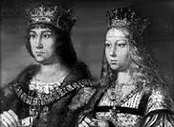






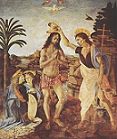
1474 On Aug. 25 infant king (since July 10, 1473) James III (b. 1473) dies under suspicious circumstances, and on Aug. 26 her mother Caterina (Catherine) Cornaro (1454-1510) becomes queen of Cyprus (until Feb. 26, 1489), watching the weakened kingdom become controlled by Venetian merchants. The final Roman Catholic V against the Muslims in Spain is owed to a king with a limp dick and/or dry nuts? On Dec. 11 Castile-Leon king (since 1454) Henry IV the Impotent (b. 1425) dies without a male heirs and his half-sister Isabella I the Catholic of Castile and Leon (1451-1504) and her hubby Ferdinand II the Catholic of Aragon (1452-1516) (royal cousins, married in 1469) jointly succeed him as Ferdinand V and Isabella I of Castile and Leon (until 1504), uniting all of Spain except Moorish Granada, but not without a little War of the Castilian Succession (ends 1479), with Afonso V of Portugal supporting the claim of Henry IV's only child, 12-y.-o. daughter (Isabel's and Afonso's niece) Juana (Joanna) la Beltraneja (1462-1530), going through with an extreme marriage with her next May 30 in Plasencia in Extremadura (W Spain); too bad, even though John IV made his nobles promise to support her as queen, not only was he a weak king, but he was known for shooting blanks, having divorced his 1st wife Blanca in 1453, leaving her a virgin after 13 years of marriage, and it is widely rumored that Juana is really the below-the-belt daughter of Beltran (Beltrán) de la Cueva y Alfonso de Mercadeo, 1st Duke of Albuquerque (1443-92) (hence her nickname La Beltraneja), which was reinforced when John's 2nd wife Juana had a love child with the nephew of Bishop Fonseca, causing him to divorce her - you're combat ineffective, do you understand me? Mehmed II takes Cilicia. About this time Stjepan Hercegovic (1459-1517), son of king Herceg Stefan of Hercegovina converts to Islam, later returning in 1515 from several years in Istanbul as Otoman grand vizier Ahmed Pasha Hercegovic (Hersekzad) (Hersekli) (Ahmed Pasha, Son of the Herzog), helping the Bosnian nobility go Muslim; the Christian peasants are jizya-taxed in money and children, who are turned into Janissaries - great dress? The Hapsburgs give up trying to fight the militant Swiss mountaineers, and abandon their attempts to assert feudal rights, letting the Swiss Confederation (formed 1291) become a sovereign part of the HRE. England and Scotland sign the Treaty of 1474, but the pesky Scots like border-raiding so much that it becomes unworkable. Christian I of Denmark travels to Rome and arranges with the pope to be allowed to fill the highest church posts in Denmark and Sweden, and open a univ. in Copenhagen; Christian I's title of Duke of Schleswig and Count of Holstein is consolidated into Duke of Schleswig-Holstein. The Hanseatic League secures full title to their steelyard in London, and renewal of their rights in Boston and Lynn. The town of Urbino, Italy in the Marches 19 mi. SW of Pesaro becomes capital of the duchy of Urbino (until 1626), becoming known as an art center. Girolamo Savonarola (1452-98) hears a sermon, renounces the world, and becomes a Dominican - he couldn't just come out of the closet in those days? James III gets his court servant-tailor William Scheves (-1497) appointed as archdeacon of St. Andrews, then coadjutor of the see of St. Andrews on July 13, 1476 on the grounds of the insanity of his enemy archbishop Patrick Graham, and finally archbishop in 1487 after Graham is deposed - bringing in the scheves? The Iroquois Constitution observes peace among the Five Nations. Gentile Bellini (1427-1507), son of Jacopo (Iacopo) Bellini becomes official Venetian state painter. The U. of Saragossa (Zaragoza) in NE Spain is founded, going on to distinguish itself for mediocrity? The Repub. of Venice enacts the first modern patent law. Architecture: The Dakhil Gateway in Gaur, Bengal (begun 1459) is finished. Science: Regiomontanus pioneers lunar nautical navigation. Art: Hans Memling (1433-94), St. John Altarpiece (1474-9). Andrea del Verrocchio (1436-88), The Baptism of Christ (1474-5); his pupil Leonardo da Vinci finishes the background and paints the left angel, outshining his master and causing him to switch mainly to sculpture? Nonfiction: Bartolomeo Platina (1421-81), De Honesta Voluptate et Valetudine (On Honorable Pleasure and Health) (5 vols.); the first printed cookbook, containing mainly Roman medieval recipes incl. some from Maestro Martino de Rossi, whom he met in summer 1463 in Albano. Poetry: ?, The Recuyell of the Historyes of Troye; the first book printed in the English language, tr. and printed by William Caxton (1415-91) at Bruges. Births: Italian Ursulines founder (St.) Angela Merici (d. 1540) on Mar. 21 in Desenzano, Lombardy; canonized in 1807. Italian marquesa of Mantua (1490-1539) ("First Lady of the Renaissance") Isabella d'Este (d. 1539) on May 18 in Ferrara; eldest daughter of Ercole I d'Este (1431-1505) and Leonora of Naples (1450-93) (daughter of Ferdinand I); sister of Beatrice d'Este (1475-97) and Alfonso I d'Este (1476-1534); wife (1490-) of Francesco II Gonzaga (1466-1519). Italian "Orlando Furioso" poet Ludovico Ariosto (d. 1533) on Sept. 8 in Reggio Emilia. German Saxon duke Frederick (Friedrich) von Wettin (von Sachsen) (d. 1510) on Oct. 26 in Torgau; 3rd son of Duke Albert (1443-1500) and Zedena of Bohemia (daughter of George of Podebrady); grandmaster #36 of the Teutonic Knights (1498-1510). Italian diplomat cardinal (1534-9) (last cardinal protector of England in 1523-31) Lorenzo Campeggio (d. 1539) on Nov. 7 in Milan; educated at the U. of Bologna; becomes a priest after his wife Francesca (five children) dies. English pretender Perkin Warbeck (d. 1499) in Tournai, Belgium. Spanish explorer Vasco Nunez (Núńez) de Balboa (d. 1519) in Jerez de los Caballeros, Spain; first Euro to discover the Pacific. Italian mistress Giulia Farnese (d. 1524) in Canino; mistress of Pope Alexander VI (Rodrigo Borgia); mother of two of his sons, and sister of "the Petticoat Cardinal" Alessandro Farnese (later Pope Paul III); has floor-length golden hair, is featured in Raphael's Transfiguration, and is the model for Pinturicchio's Virgin Mary painting in the papal apts. Spanish (Portuguese?) explorer Diego Colon Moniz (d. 1526) in Lisbon (1479/80 in Porto Santo?); eldest son of Christopher Columbus (1451-1506); brother of Ferdinand Columbus (1488-1539). Amerindian Roman Catholic (St.) Juan Diego Cuauhtlatoatzin (d. 1548); first Roman Catholic indigenous saint from the Americas. Deaths: Franco-Flemish composer Guillaume Dufay (b. 1397) on Nov. 27. Spanish king (1454-74) Henry IV the Impotent of Castile (b. 1425) on Dec. 11. Cyprus king (1473-4) James III (b. 1473) on Aug. 25; dies under mysterious circumstances.
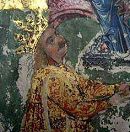


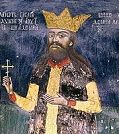
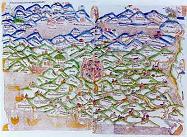

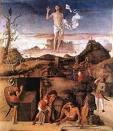

1475 On Jan. 10 after the Ottomans invaded Moldavia last Dec. and advanced onto scorched earth and poisoned waters, the Battle of Vaslui (Racova) (Podul Inalt) on a foggy morning is a big V for Moldavian prince (since 1457) Stephen III the Great (1433-1504) and his 45K Christian troops and 5K troops from Hungary and Poland plus 30K peasants armed with homemade weapons against 120K Ottomans under Hadan Suleiman Pasha, who sustain 40K casualties (30K killed) by the time they hightail it out of Bessarabia, becoming the greatest V ever secured by the Christians against Islam, and the worse defeat ever for the Ottomans, saving the Christian world from Islam and causing Pope Sixtus IV to award Stephen the title of Athleta Christi (champion of Christ), and call him "Verus christiane fidei aletha" (the true defender of the Christian faith); like a true athlete of Christ, Stephen doesn't celebrate his V like some pagan Roman, but fasts for 40 days on bread and water and gives credit only to the Lord, and orders monasteries built and decorated with colorful frescoes, incl. the Church of St. George of Voronet Monastery (1488), whose exterior walls are painted in 1547 with a Last Judgment scene in vivid cerulean blue (later known as Voronet blue), becoming known as "the Sistine Chapel of the East"; in 1490 he builds the Monastery of the Beheading of St. John the Baptist; after getting over the shock, the Big D pisses-off Sultan Mehmed II, who vows here-comes-Johnny-again revenge; meanwhile Vlad III Dracula's younger brother Radu cel Frumos (the Handsome) (b. 1435) (who converted to Islam) dies, and Basarab Laiota cel Batran (the Elder) of the Danesti clan is installed by the Ottomans as prince of Wallachia, causing Vlad III Dracula, who was officially released from imprisonment in Hungary last year by Hungarian king (1458-90) Matthias Corvinus (1443-90) to invade Wallachia with Stephen V Bathory of Ecsed (1430-93) with a mixed force from Transylvania that includes some Moldavian troops sent by Vlad's cousin Stephen III of Moldavia, causing Basarab to flee to the protection of the Turks, after which Bathory places Dracula on the throne of Wallachia then returns to Transylvania, leaving Vlad with a force of only 4K men, which he fails to increase after the boyars and peasants alike tell the vamp to shove it? In the summer the Portuguese under Afonso V siege and take Toro, after which Afonso V refuses to fight the Castilian relief army under Ferdinand II of Aragon, and Ferdinand's army disperses, but the Portuguese are kept cooped up in Toro by other supporters of Isabella I. In the summer George "the Rich" of Bavaria-Landshut (1455-1503) marries princess Jadwiga (Hedwig) Jagiellon (1457-1502) (pinup girl of the Middle Ages?), daughter of Casimir IV Jagiellon of Poland and Archduchess Elisabeth of Austria in one of the most celebrated weddings of the Middle Ages, starting the tradition of the Landshut Wedding (Landshuter Hochzeit), held every four years in modern times and attended by 2K+ participants in medieval costumes, who joust, feast, and you know what all night long. On Aug. 29 after Edward IV arrives in France with a large army to make war on Louis XI, and Edward IV's ally the Duke Charles III the Bold of Burgundy proves too busy fighting the Germans to aid him, the Treaty of Picquigny is signed, giving Edward IV 75K crowns plus 50K crowns a year to return to England and give up his claims to the French throne; Louis IX also agrees to ransom Queen Margaret of Anjou with 50K crowns to exile in Anjou, and pay pensions to many of Edward's other lords; Duke Richard of Glouchester (later Richard III) opposes the treaty and turns the picayune pension down; the new source of dough frees Edward IV from reliance on Parliament for money and leaves him free to concentrate on domestic affairs, particularly his bank account, confiscating Yorkist estates, extorting benevolences (free forced gifts), pumping up the wool trade and raking in customs duties. In Oct. James III of Scotland summons John MacDonald (John of Islay), Earl of Ross (1434-1503), 4th and last lord of the isles (since 1449) to appear in parliament on Dec. 1 to answer charges of treason stretching back to 1452, and when he doesn't show up parliament passes a sentence of forfeiture, and on Dec. 4 commissions his rival Colin Campbell, 1st Earl of Argyll, 2nd Lord Campbell (1433-93) to do the dirty work, which he does next spring, with help from Robert Colquhoun, bishop of Argyll (1475-93), Earl John Stewart of Atholl, and Earl George of Huntly. The Ottoman Turks annex the Crimea, continue their attack on Venice, and become masters of the Aegean Sea. Dayan ("Great Yuan") Khan (Batumongke) (1464-1517) reunites the Mongols in Mongolia, becoming the Khalka Mongols, the largest subgroup of Mongols in Mongolia since the 15th cent. (modern-day pop. 3M). German astronomer Regiomantanus (Johann Muller) (1436-76) is called to Rome by Pope Sixtus IV to help the reform of the pokey Julian Calendar, which was started in -44 and is now eight days behind, with the vernal equinox falling on Mar. 12 instead of Mar. 20; too bad, Regiomontanus dies of the plague next year before doing it, and nothing is done until the Council of Trent in 1545. After coffee arrives in Turkey in 1453, Kiva Han, the world's first coffee shop opens in Constantinople (Istanbul) - Crescentbucks? Architecture: Porta del Popolo in Rome is built by Pope Sixtus IV for the Jubilee Year of 1475 on the site of the partially-buried Roman Porta Flaminia gate, becoming a gate of the Aurelian Walls. St. Olaf's Castle (Olavinlinna) in Savonlinna, Finland is built, becoming the site of an annual opera festival in 1912. Inventions: Majolica glazed pottery, first manufactured in this cent. in Majorca, "pearl of the Mediterranean" begins to be manufactured in Urbino, Italy. About this time the muzzle-loaded rifle is developed in Italy and Germany - who's the best shot? Nonfiction: Lucas Brandis pub. the first two printed maps; wouldn't you know, they're of the Holy Land and Jerusalem? The fechtbuch Gladiatoria is pub. about this time in Germany. Art: Giovanni Bellini (1428-1507), The Resurrection (1475-9). Andrea del Verrocchio (1435-88), Madonna, St. John the Baptist and St. Donatus (1475-83). Births: Italian duchess of Milan (1494-7) Beatrice d'Este (d. 1497) on June 29 in Ferrara; daughter of Ercole I d'Este (1431-1505) and Leonora of Naples; sister of Isabella d'Este (1474-1539) and Alfonso d'Este (1476-1534); wife (1491-) of Lodovico Sforza (1452-1508). Spanish humanist scholar Hernan Nunez de Toledo y Guzman (Hernán Núńez de Toledo y Guzmán) (d. 1553) in Valladolid. Italian Mannerist Fontainebleau architect Sebastiano Serlio (d. 1554) on Sept. 6 in Bologna. Italian soldier-cardinal Cesare Borgia, Duke of Valentino (d. 1507) on Sept. 13 in Rome; illegitimate son of Rodrigo Borgia (Pope Alexander VI), and subject of Machiavelli's "The Prince". German satirist Thomas Murner (d. 1537) on Dec. 24 in Oberehnheim, Alsace. English poet Stephen Hawes (d. 1511). Spanish explorer Lucas Vazquez de Ayllon (Lucas Vázquez de Ayllón ) (d. 1526) in Castile. English cardinal (1515-), statesman and lord chancellor (1515-29) Thomas Wolsey (d. 1530) (b. 1474?) in Ipswich; son of a butcher; educated at Magdalen College, Oxford U. Italian painter Bernardino Luini (Bernardino de Scapis) (d. 1532) in Runo (Luino?), Dumenza (near Lake Maggiore); son of Giovanni Lutero; pupil of Leonardo da Vinci; known for painting females with slightly squinted "Luinesque" eyes. Italian engraver Marcantonio Raimondi (d. 1534) (b. 1470?) in Bologna; pupil of Francia of Bologna; pirates about 70 engravings by rival Albrecht Durer (1471-1528), counterfeiting his signature - you complete me? English Yorkist imposter Lambert (John) Simnel (d. 1535); claims to be the earl of Warwick. Spanish conquistador Diego de Almagro the Elder (El Viejo) (El Adelantado) (d. 1538) in Amalgro (near Ciudad Real), Castile; father of Diego de Almagro the Younger; partner then enemy of Francisco Pizarro. Spanish novelist Fernando de Rojas (d. 1538) in Toledo. Italian "The Last Judgment" #1 artist-sculptor (lefty) Michelangelo di Lodovico Buonarroti Simoni (d. 1564) in Caprese; student of Bertoldo di Giovanni (1435-91), student of Donatello (1386-1466); only Renaissance artist to adopt Neoplatonism in its entirety? Deaths: Italian Florentine painter Paolo Uccello (b. 1397) on Dec. 10 in Florence. Italian humanist historian Matteo Palmieri (b. 1406); declared a heretic by the Church, his body is removed from the Church of San Pier Maggiore and his effigy burned for writing the unpub. 3-vol. poem The City of Life in imitation of Dante's "Divine Comedy", claiming that the world was divinely ordained to test human virtue in action. Dutch Flemish painter Dirk Bouts (b. 1410). French theologian Alanus de Rupe (b. 1428) in Zwolle, Netherlands. Wallachian prince (1462-75) Radu the Handsome (b. 1437). Poruguese infanta Juana (Joana) (b. 1439) on June 13 in Madria; dies in a convent.
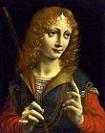



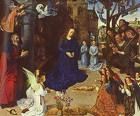
1476 In Feb. after the Castilians under Ferdinand V siege Portuguese-held Zamora, Alfonso V comes to Zamora's relief, then withdraws towards Toro in Castile-Leon; Ferdinand and his 8K men and 2.5K3K horsemen pursues and catches them on Mar. 1 only 5 mi. from Toro as they negotiate a narrow pass beside the Duero River, and fight the Battle of Toro; 1K of 8K Portuguese footmen and 3.5K horsemen are KIA, but the rest escape to fight again, despite Isabella I and Ferdinand II beginning to assume the Spanish throne; next Nov. Afonso V flirts with making his son John II co-king before retiring to a monastery in Sintra and remaining king until his 1481 death. On Mar. 2 after hanging dead Swiss 10-to-20 per bough on trees, pissing them off, Charles III the Bold of Burgundy is outwitted and defeated by the Swiss at the Battle of Grandson, who don't have the calvary need to chase them but take a large amount of booty incl. bling, then decisively defeated on June 22 at the Battle of Morat (Murten), which ends in a rout with their backs up against a lake, allowing the Swiss to drive them into it and drown them, with 6K-10K Burgundian casualties out of 12K-20K vs. 410 out of 25K for the Swiss, who capture yet more booty and bling, incl. three capes of the Order of the Golden Fleece, after which Charles III the Bold holes-up in Morges, followed by Pontarlier, licking his wounds and knowing that his Duchy of Burgundy is on its last legs. On Mar. 24 street drummer Hans Bohm claims to have a vision of the Virgin Mary in the village of Nikleshausen, Germany, then burns his drum in a Bonfire of the Vanities, and proclaims the village the landing pad for the Second Coming of Christ, telling his followers to become Christian communists and not pay rent; after tens of thousands of peasants flock to him from all over Germany, causing a peasant revolt in May, the authorities crack down, and Drummer Boy Bohm is burned at the stake on July 19. In June 150K Ottomans under Sultan Mehmed II invade Bessarabia to get even for last year's big D, and are joined by 10K Wallachians and 30K Tartars from the Crimea, who are repelled at the cost of dispersing the Moldavian forces of Stephen III, leaving him with only 12K-20K men, who are defeated on July 26 at the Battle of Valea Alba (Razboieni) (Akdere), destroying almost the entire army, causing the battlefield to become known as White Valley for the carpet of bones, after which Stephen (who has to be dragged from the battle because he won't give up?) retreats to the NW and recruits another army, while the Ottomans fail to capture any Moldavian strongholds and begin suffering from plague and starvation, causing them to retreat in Aug.; meanwhile the Wallachians under Laiota are chased back to Wallachia by Vlad III Dracula and Stephen Bathory of Transylvania and their 30K-man army (which arrives too late to help Stephen III at Valea Alba, then joins him on Aug. 18), causing Stephen III to regroup and invade Wallachia from the N with 15K men, while Dracula and Bathory invade from the W (S Transylvania) with 35K men, defeating Laiota and his 18K men in Nov. at the Battle of Rucar (15 mi. from Bran at the Transylvanian-Wallachian border) with casualties of 10K on each side, then capturing Bucharest on Nov. 16, after which Dracula is reinstalled on the Wallachian throne on Nov. 26, with 200 loyal knights given to him by Stephen as bodyguards; too bad, after Stephen and Bathory leave, Prince Basarab Laiota *returns in Dec. and catches Vlad III Dracula (b. 1431) with his 4K-man mini-army, killing him near Bucharest (assassinated by his own boyars?), then takes his head *preserved in perfume and honey to Constantinople to please the sultan; he is really just scalped then buried by his grandfather Radu Florescu? On July 10 chastened law-unto-himself John Macdonald appears before a packed Scottish parliament in Edinburgh and is stripped of the earldom of Ross, which is reserved for James III's 2nd son; after Queen Margaret intervenes, he is given the landless title of lord of the Isles to work as an agent of the crown and keep the other pesky rebels down (until 1499). On Dec. 26 widely-hated Milan duke (since 1466) Galeazzo Maria Sforza (b. 1444) is assassinated by three Milan court officials in the Church of Santo Stefano, and his 7-y.-o. son Gian Galeazzo Sforza (1469-94) becomes duke of Milan under the regency of his mother Bona of Savoy, Duchess of Milan (1449-1503), marrying his first cousin Isabella of Aragon (Naples) (1470-1524), daughter of Alphonse II of Naples (duchess of Milan from 1499-1524), who is later alleged to be the model for Leonardo da Vinci's "Mona Lisa", and to even have secretly married the boy-friendly dude; the Pazzi Plot (Conspiracy) (Congiura dei Pazzi) to knock off the Medici is hatched by the Sforza, along with the Medicis' Florentine rivals the Pazzis and Pope Sixtus IV; Federico III da Montefeltro, duke of Urbino, who pretends to be Lorenzo de' Medici's friend is secretly in on it? Ferdinand V organizes the Santa Hermandad (Holy Brotherhood), a nat. military police enforcing religious conformity, centered in Castile. Mehmed II defeats the Christians and Mongols in the Balkans, and seizes Moldavia from the Christians. Margaret of Anjou is ransomed by Louis IX of France for 50K crowns in return for surrendering to him her rights to the Anjou lands, and she returns to France for life (until 1482). The Chimu-Inca War (begun 1462) ends with the Chimu state defeated and the pop. resettled in the city of Cuzco as slaves. William Caxton returns from Germany to England and sets up a printing press at Westminister Abbey under the patronage of Edward IV. Art: Hugo van der Goes (1440-82), Portinari Alterpiece (Triptych); the Adoration of the Shepherds, commissioned by Bruges Medici agent Tommaso Portinari and donated to the Hospital of Santa Maria Nuova in Florence, becoming a favorite of the Italian masters. Births: Italian Roman pope (1555-9) ("Father of the Roman Inquisition") Paul IV (Giovanni Pietro Carafa) (d. 1559) on June 28 in Capriglia Irpina (near Avellino); big fan of Thomas Aquinas; a stint as papal nuncio in Spain causes him to develop a lifelong hate for the Spanish - this one's for Paul? Italian duke of Ferrara (1505-34) Alfonso I d'Este (d. 1534) on July 21 in Ferrara; eldest son of Ercole I d'Este (1431-1505) and Leonora of Naples (1450-93) (daughter of Ferdinand I of Naples); brother of fellow art patron Cardinal Ippolito I d'Este, Isabella d'Este (1474-1539), and Beatrice d'Este (1475-97); husband of Anna Sforza and Lucrezia Borgia. Italian noblewoman Anna Sforza (d. ?) on July 21 in Milan; daughter of Duke Galeazzo Maria Sforza (1444-75); wife (1491-) of Alfonso I d'Este (1476-1534). Korean Joseon king #10 (1494-1506) Yeonsan-gun (Yosan Gun) (d. 1506); eldest son of Seongjong and 2nd wife Lady Yoon; worst tyrant in Joseon Dynasty history? Scottish poet Gavin Douglas (d. 1522). Spanish (Basque) round-the-world explorer Juan Sebastian del Elcano (del Cano) (d. 1526) in Getaria, Gipuzoa, Castile. English knight Sir William Kingston (d. 1540). Italian explorer-cartographer Sebastian Cabot (d. 1557) (b. 1474?) in Venice; son of explorer John Cabot (1450-1498). Japanese court painter Kano Motonobu (d. 1559) in Kyoto. Deaths: English jurist Sir John Fortescue (b. 1394); leaves On the Governance of the Kingdom of England, and De Laudibus Legum Angliae, favorably comparing English common law to French and ancient Roman, with the soundbyte "One would much rather that twenty guilty persons should escape the punishment of death, than that one innocent person should be condemned and suffer capitally"; he writes that the English king should be the richest man in the kingdom in order to rule well. Romanian blood lite lover Vlad III Dracula the Impaler (b. 1431) in Dec. in Snagov ("snow") ("corpse"?) 15 mi. N of Bucharest; killed and beheaded by boyars, the perfumed head sent to the sultan as a gift; buried in Snagov Monastery on Lake Snagov; his body is never found?; in 2005 Matei Cazacu (1946-) opens his grave in Snagov Monastery for British documentary film crew David Paradine Productions, and his remains turn to dust in a few min., showing a cloth placed over his face (proving he was faceless not headless?). English archbishop of Canterbury (1465-76) George Neville (b. 1432) on June 8. German scientist Regiomontanus (b. 1436) on July 6 in Rome (plague); leaves De Triangulus, which becomes the std. textbook on trigonometry. Italian duke of Milan (1466-76) Galeazzo Maria Sforza (b. 1444) on Dec. 26 in Milan (murdered in the Church of Santo Stefano).




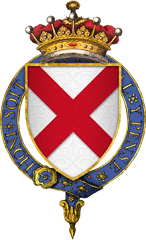


1477 On Jan. 5 Charles III the Bold (b. 1433), last duke of Burgundy is defeated and KIA at the Battle of Nancy by troops of Duke Rene II of Lorraine and Guise (1451-1508) and the Swiss army, after which Spanish courtier Diego de Guevara (1450-1520) throws himself over the dead body; days later his naked animal-eaten body is discovered, with a physician needed to ID him; Louis XI seizes Burgundy and Picardy and prepares to annex the Low Countries, Artois, Luxembourg, and Franche-Comte, while in Feb. Charles III the Bold's daughter Mary of Burgundy (1457-82), heiress to Burgundy, the Netherland provinces, and Luxembourg grants the Great Privilege, restoring the liberties of the provincial estates in order to fight Louis XI; Charles III the Bold's death begins a slide towards division between France and the Hapsburgs, becoming a major factor in most W Euro wars for the next two cents.; in May after HRE Frederick III arranges it, she marries his son Archduke Maximilian of Austria (1459-1519) (later HRE Maximilian I) in order to gain his support against Louis XI, and the Hapsburgs acquire the Netherlands, which doesn't look bad in their asset sheets; the first time a diamond engagement ring is given, starting a fashion?; Diego de Guevara becomes Mary's esquire, continuing after her 1482 death in the service of her son Duke Philip the Handsome, and after his 1506 death becoming councillor-chamberlain to HRE Charles V; Maximilian extends the Order of the Golden Fleece (founded in 1430 by Philip III the Good) to Austria. On Feb. 14 Margery Brews sends a letter to John Paston in Norfolk, England, addressed "To my right wellbelovyd Voluntyne", becoming the world's first known Valentine. On Mar. 25 Irish lord chancellor of Ireland Thomas FitzGerald, 7th Earl of Kildare (b. 1421) dies, and his eldest son Gerald FitzGerald, 8th Earl of Kildare (1456-1513) (AKA Garret the Great Earl) becomes lord deputy of Ireland (until 1494, then 1496-1513), becoming so powerful that he is called "the uncrowned king of Ireland", with the common saying: "Since all Ireland cannot control the Earl of Kildare, then Kildare must control all of Ireland"; after he dies a legend arises that he slumbers in a cave beneath the Currah of Kildare, and awakens every seven years on May Day, riding around the Curragh on his seed; when his horse's shoes are worn down to the thickness of a cat's ear, he will allgedly lead the Irish army to drive the stankin' English out and reign as king for 40 years. On Nov. 18 William Claxton prints the first dated book in English, Dictes & Sayengis of the Phylosophers by Earl Rivers (tr. from the French); he also prints Chaucer's Canterbury Tales for the first time ever. Matthias Corvinus starts a war against HRE Frederick III. The Ottomans expand their control over virtually all of Albania, and take S Montenegro (1477-8), outflanking the Venetians and causing them to cry uncle? In Nov. after returning to Portugal, defeated Afonso V retires for a few days in favor of his son John (Joao) II, then returns and retires again to a a monastery in Sintra, dying on Aug. 28, 1481. Fra Alonzo de Hojeda, prior of the Convent of San Pablo launches a virulent Easter campaign against the city's Marranos (Sp. "swine") (conversos), Jews who feign conversion to Catholicism. The Onin War in Japan (begun 1467) ends after rival warlords die of natural causes, leaving Shogun Yoshimasa in control. The Burgundian Order of the Golden Fleece (founded 1430) becomes a Hapsburg order. The U. of Mainz, whose papal approval was begun by Mainz archbishop Adolf II of Nassau is donated to the city by his successor (since Nov. 1475) Mainz archbishop Diether von Isenburg (1412-82). The U. of Tubingen (Tübingen) is founded in Tubingen, Baden-Wurttemberg, Germany by Renaissance-loving Eberhard I, 1st Duke of Wurttemberg (1445-96), becoming one of the five classical univ. towns in Germany (incl. Freiburg, Gottingen, Heidelberg, and Marburg), and the #1 German univ. for the study of theology and religion. Uppsala U. in Uppsala, Sweden is founded via a bull by Pope Sixtus IV, who grants it the same freedoms and privileges as the U. of Bologna, becoming the oldest univ. in Scandinavia, not counting the Academy of Lund (founded in 1425). Sports: Edward IV bans cricket because it distracts the royal army from archery practice. Architecture: Ming Emperor Xian Zong builds Xi Chang. Nonfiction: Antonio Bettini (1396-1487), Monte Santo di Dio (Florence); how a good Roman Catholic can use science and virtue to become closer to God; printed by Nicolaus Lorentii; first printed work to contain copperplate engravings, by Baccio Baldini, based on designs by Sandro Botticelli. Ludolph the Carthusian, Life of Christ (Cologne); claims to reprint a letter by 1st cent. Judaean govt. Publius Lentulus witnessing to the fact of Jesus Christ, incl. his appearance; a forgery? Art: Sandro Botticelli (1445-1510), La Primavera (1477-8); filled with humanist and pagan ideas, showing Venus celebrating the arrival of spring, a metaphor for the rebirth of Florence under his Medici patrons; elaborates the theme of Arcadia and the underground stream. Michael Pacher begins painting the Altar at St. Wolfgang in Austria (finished 1481). Veit Stoss begins the carved Altar at St. Mary's in Cracow (finished in 1489). Poetry: Blind Harry (1440-92), The Wallace (The Actes and Deidis of the Illustre and Vallyeant Campioun Schir William Wallace); a verse history of Scottish hero Sir William Wallace (1272-1305), which becomes the Scottish nat. epic., the #2 most popular book in Scotland after the Bible; too bad, it's full of inaccuracies; the earliest known copy is made in 1488 by John Ramsay, 1st Lord Bothwell. Births: French queen consort (1491-1514) Anne (Anna) of Brittany (d. 1514) on Jan. 25 in Nantes, Brittany; daughter of Duke Francis II of Brittany (1433-88) and Margaret of Foix (1453-86); maternal granddaughter of Eleanor of Navarre (1425-79). Venetian painter Il Giorgione (Giorgione da Castelfranco) (Giorgio Barbarelli) (d. 1511) in Castelfranco; raised in Venice, where he is apprenticed to Giovanni Bellini; his works are so similar to those of Titian that they get confused - Giorgione was from Venice, Giotto was from Florence? Italian painter Galeazzo Campi (d. 1536) in Cremona; father of Giulio Campi (1502-72), Antonio Campi (-1591) and Vincenzo Campi (1536-91). English diplomat-politician and stud horse Thomas Boleyn, 1st Earl of Wiltshire and Ormonde (d. 1539) in Hever Castle; husband of Elizabeth Howard (1480-1538), daughter of Thomas Howard, 2nd duke of Norfolk (1443-1524); father of Anne Boleyn (1507-36), Mary Boleyn (1499-1543), and George, viscount Rochford (1504-36); maternal grandfather of Elizabeth I. Italian High Renaissance Mannerist painter (sodomite?) Il Sodoma (Giovanni Antonio Bazzi) (d. 1549) in Vercelli, Lombardy; pupil of Leonardo da Vinci from 1498-1500, causing their paintings to later be confused; dresses gaudily, keeps a Noah's Ark of a house, and becomes known as "Il Mattaccio" (the Madcap); marries and separates young, leaving a daughter who marries Bartolomeo Neroni; a sodomite? Italian (Venetian) painter and #1 portraitist Titian (Tiziano Vecellio) (Tiziano Vecelli) (d. 1576) (b/ 1488?) in Pieve di Cadore; #1 painter of the Venetian School; pupil of Gentile and Giovanni Bellini; known for the reddish yellow or auburn (titian) hair in his portraits, as well as rich effects in red, green, yellow, and blue; pioneers atmospheric perspective and impressionism; the #1 landscape painter until Nicolas Poussin (b. 1593); one of the first three Venetian rock stars, along with writer Pietro Aretino and architect Jacopo Sansovino? Deaths: Irish statesman Thomas FitzGerald, 7th earl of Kildare (b. 1421) on Mar. 25. French duke of Burgundy (1467-77) Charles the Bold (b. 1433) on Jan. 5 in Nancy (KIA).







1478 On Feb. 11 after Patrick Graham is excommunicated and deposed, James III's puppet (who used to sew his shirts) William (bringing in the?) Scheves becomes archbishop of St. Andrews. On Feb. 18 after the English Parliament condemns for treason and imprisons Edward IV's brother George Plantagenet, 1st Duke of Clarence (b. 1449) ("false, fleeting, perjur'd Clarence") in the Devereux Tower (part of the Tower of London), he "disappears privately", rumored to having been drowned in a butt (large cask) of malmsey (strong sweet white Madeira, as opposed to claret, which is dry red) wine (blamed by Shakespeare on his scheming brother Richard?); on Feb. 21 Duke Richard of Gloucester gains Clarence's share of Warwick's lands, along with the title of Great Chamberlain; the news of his bro's death causes the grievously ill king's death, according to Shakespeare - so much for Sir John Fortescue? On Apr. 7 John Macdonald, ex-earl of Ros is summoned before the Scottish parliament again on charges of resisting royal authority in the W highlands, but this time it's his pesky bastard son Angus Og of Islay, so Macdonald gets off and is a broken horse now, allowing Earl Colin Campbell of Argyll to become big boss in the Kilted West? The original patsy was a lone knifeman but there is a conspiracy? On Apr. 26 (Easter Sunday) after the Riorios and Pazzis plot against them, Giuliano de' Medici (b. 1453), brother of Lorenzo the Magnificent and co-ruler of Florence is murdered (stabbed 19x) in the Duomo of Santa Maria del Fiore Cathedral in Florence during Mass by Bernardo Bandini and Francesco de' Pazzi (b. 1444), who also attempts to kill Lorenzo, and wounds him, but stabs himself in the thigh as he has Giuliano on the ground; Medici supporters get violent and exact revenge, and the same day Pazzi is thrown naked with a noose around his neck from a window in the Palazzo Vecchio, along with the archbishop, who locks his teeth in his flesh?; Lorenzo then hears that the pope had been behind the plot, and has sent troops to wipe the Medicis out, and travels alone to Naples and buys the troops off, then returns to Florence where he is hailed as "il Magnifico" ("virtuous spender of one's wealth"?), and adopts the illegitimate son of his dead bro', then consolidates his power and almost exterminates the Pazzi family; Medici man Sandro Botticelli paints the execution scene on the wall of the Bargello prison for 40 florins - see Thomas Harris' 1999 novel "Hannibal", Ch. 17? There's no business like show business? At the request of Ferdinand II and Isabella I the Catholics of Spain, Pope Sixtus IV pub. the bull Exigit Sinceras Devotionis Affectus authorizing Christian kings and queens to appoint inquisitors to deal with offenders against the Church, esp. Marranos (Sp. "swine") (swine-eaters?), Christian converts still secretly practicing Judaism; the Spanish Inquisition begins (ends 1834), initially concentrating on conversos, but soon expanding its deadly gaze to anybody who gets in the Church's way (see 1615)? On June 14 Federico I Gonzaga (1444-84), husband of Margaret of Bavaria (daughter of Duke Albert III of Bavaria) becomes marquis of Mantua in Lombardy (until 1484). 4-y.-o. Richard of Shrewsbury, 1st duke of York, son of Edward IV of England is married to 6-y.-o. Anne de Mowbray, 8th Countess of Norfolk (1472-81), who becomes duchess of Norfolk; too bad, she dies in Greenwich, London in 1481, two years before her hubby disappears into the Tower of London with older brother Edward V; luckily, Edward IV has Parliament pass an act stating that should Anne die before Richard, her dukedoms would go to Richard and not to her other relatives. The civil war in Bohemia ends with both Ladislaus II and Matthias Corvinus keeping the title of king. The Turks under Mehmed II siege Kruje for the first 4th time, and capture it after promising safe passage to the defenders, then reneging and killing the men and enslaving the women and children, taking the younger women as wives; having resisted the Ottomans since 1474, Shkodra (Shkoder) in N Albania finally falls to Mehmed II after a heroic struggle, the peace treaty with the Venetians next Jan. 25 permitting the defenders to leave unharmed for real, after which many flee to Italy, Greece, Egypt and other countries, leaging the Turks a free hand to Muslimize Albania. White Sheep Turks (Aq-Qoyunlu) ruler (since 1452) Uzun Hasan dies after defeating the Black Sheep and occupying Iraq, Azerbaijan and W Iran, leaving a kingdom plagued by wars of succession until the Safavids end the dynasty in 1508; his son Ya'qub (d. 1490) becomes ruler of the White Sheep Turks (until Dec. 14, 1490), beginning to fear the growing Safavid order and plot to kills its leader Haydar. Ivan III of Moscow subdues Novgorod, annexing it and acquiring all of N Russia from Lapland to the Urals. The Spanish Christians and the Muslim Granadans agree to a truce - which must mean that the Muslims need to buy time? Italian poet Matteo Maria Boiardo, Conte di Scandiano (1440-94) is appointed gov. of Reggio Emilia by his patron Duke Ercole d'Este. Art: Sandro Botticelli (1445-1510), Portrait of Giuliano de' Medici. Il Perugino (1445-1523), St. Sebastian (Castel Cerqueto, Perugia). Martin Schongauer (1448-91), Jungen Frau. Andrea del Verrocchio (1435-88), Winged Cherubim with Dolphin (scultpure) (Careggi Villa). Leonardo da Vinci (1452-1519) gets his own studio in Florence (until 1482), and is now independent of his master Verrochio; he makes a famous sketch, then in Oct. begins Madonna and Child with Flowers (Benois Madonna), known for her toothless smile, which is lost until 1909, when architect Leon Benois exhibits it in St. Petersburg and wows everybody, causing it to be called the "Benois Madonna". Nonfiction: Luca di Pacioli (1445-1517), Tractatus Mathematicus ad Discipulos Perusinmos; 600-page textbook on merchant artithmetic, dedicated to his students at the U. of Perugia. The first printed book on mathematics, L'Arte dell' Abaco is pub. in Treviso, Italy. Aulus Cornelius Celsus' 1st cent. C.E. book De Medicina is printed in Florence, Italy, spurring research in surgery. Births: English traitor Edward Stafford, 3rd Duke of Buckingham (d. 1521) on Feb. 3 in Breconshire, Wales; eldest son of Henry Stafford, 2nd Duke of Buckingham (1454-83). English "Utopia" humanist statesman-writer (Roman Catholic) Sir (St.) Thomas More (d. 1535) on Feb. 7 in London; educated at Canterbury Hall (Christ Church), Oxford U.; knighted in 1521; beatified on Dec. 29, 1886 by Pope Leo XIII, and canonized on May 19, 1935 by Pope Pius XI; on Oct. 31, 2000 Pope John Paul II declares More the "heavenly Patron of Statesmen and Politicians"; feast day: July 9; likes to wear an itchy-scratchy goat hair shirt. Italian Renaissance humanist poet-playwright-diplomat Gian Giorgio Trissino (d. 1550) on July 8 in Vicenza; inventor of Italian blank verse. Spanish historian Gonzalo Fernandez de Ovieto y Valdes (d. 1557) in Aug. in Madrid. Italian "The Book of the Courtier" Neoplatonist Renaissance writer-diplomat-soldier-courtier Conte Baldassare (Baldesar) Castiglione, Count of Casatico (d. 1529) on Dec. 6 in Casatico (near Mantua), Lombardy; friend of Raphael (1483-1520); initiates the sprezzatura style, where a gentleman dresses elegantly but with intentional nonchalance. Spanish Infante John (Don Juan) of the Asturias (d. 1497); son of Ferdinand II and Isabella I. Spanish Hapbsburg king (1504-6) Philip I (the Handsome) of Castile, Duke of Burgundy (d. 1506) in Bruges, Flanders (Belgium); son of HRE Maximilian I and Mary of Burgundy; husband of Mad Juana, daughter of Ferdinand II and Isabella I; father of HRE Charles V (1500-58) and HRE Ferdinand I (1503-64); founder of the Hapsburg Dynasty in Spain - Buck Rogers comes to Wine Town? Algerian Battle of Lepanto pirate corsair and Ottoman fleet adm. Barbarossa (Redbeard) II Hayreddin (Arab. "best of the religion") Pasha (d. 1546) in Lesbos; Muslim Turkish father Yakup Aga and Christian Greek mother Katerina; has three brothers and two sisters; brother Oruc is called Baba Oruc, causing the Spanish to hear "Barbarossa" and confuse him (real name Hizir) with his red-bearded bro'? English queen's mother Margery Wentworth (d. 1550); wife of Sir John Seymour (1474-1535); mother of Queen Jane Seymour (1508-37) (3rd wife of Henry VIII); grandmother of Edward VI (1537-53). Italian physician-poet Hieronymus Fracastorius (Girolamo Fracastoro) (d. 1553) in Verona; educated at the U. of Padua; coiner of the term "syphilis". Indian poet-saint Surdas (d. 1584) in Braj (near Mathura). Deaths: English Wars of the Roses player George Plantagenet, Duke of Clarence (b. 1449) on Feb. 18 in the Tower of London (drowned in a vat of Malmsey wine?). Florentine co-ruler Guiliano de' Medici (b. 1453) on Apr. 26 in Florence (murdered). French celeb Tristan l'Hermite (b. ?); provost of the marshals of Louis XI's household.

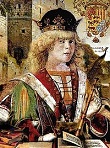


1479 On Jan. 20 John II the Great (b. 1397) dies after having a few years enjoy having his cataracts couched by Jewish physician-astrologer Abiathar Crescas, and his lucky lucky son (by his 2nd wife Juana Enriquez) Ferdinand V of Castile is crowned king Ferdinand II of Aragon, Sicily, Valencia and Majorca, finally uniting the thrones of Castile and Aragon in Spic and Span Spain, giving him the grate powah he needs to finish kicking infidel Muslim Moor butt back to Africa; his son (by Maria of Aragon, daughter of Ferdinand I of Aragon) ? On Jan. 25 Venice signs a peace treaty with the Ottomans, acknowledging defeat in the Third Ottoman-Venetian War (begun 1463), recognizing Ottoman rule in Albania and giving up most of its territories in the Aegean Sea, making it a Muslim lake; its commercial privileges are restored in return for an annual 10K ducat tribute. On Jan. 28 John II of Aragon's daughter Eleanor of Aragon (1426-79) is crowned queen of Navarre (whose crown John II had been withholding from Charles IV and Blanche II since 1441), then dies on Feb. 12, and her grandson Francis Phoebus of Foix becomes Francis I of Navarre (1469-83) (until Jan. 30, 1483), with his mother Magdalena de Valois as regent; Navarre is divided between Aragon and France, with Ferdinand II the Catholic of Castile exercising military protection over it to prevent a French invasion. On Apr. 2 the Treaty (Peace) of Olomouc allows both Vladislav II and Matthias Corvinus of Hungary to use the title of king of Bohemia, with Bohemia going to Vladislav, and Moravia, Silesia, and the two Lusatias going to Corvinus, and Corvinus' lands going to Vladislav at his death upon payment of an indemnity; happy-as-a-crow Corvinus now starts a 2nd war against HRE Frederick III - I lead a very active life, despite being bloated? On Aug. 7 Archduke Maximilian wins a V against Louis XI of France at the Battle of Guinegate, but the Low Countries remain in turmoil. On Sept. 4 after Pope Sixtus IV annuls his marriage with Juana la Beltrana as incestuous, and Louis XI refuses an offer of alliance, Afonso V of Portugal gives up and signs the Treaty (Peace) of Alcacovas (Alcáçovas) (Alcacovas-Toledo), with Alfonso V renouncing the throne of the Catholic monarchs of Castile and Aragon, and the Catholic monarchs renouncing the Portuguese throne, ending the War of the Castilian Succession (begun 1474), becoming a V for the Spanish on land and a V for the Portuguese on the sea, with the Atlantic Ocean and its territories divided into two zones of influence; Spain agrees to allow the Portuguese to monopolize trade along Africa's W coast, and Portugal acknowledges Spain's rights in the Canary Islands; Juana la Beltrana is sent by her aunt Isabella I to a convent, where she spends the rest of her life feeling cheated, signing letters "La Reina" (the Queen). In Sept. painter Gentile Bellini is sent by Venice to Constantinople to work for Sultan Mehmed II, painting his portrait. On Oct. 13 the Battle of Breadfield on the Breadfield Zsibod (Sibot) near the Maros River in Transylvania sees 12K-15K Hungarians and Transylvanians led by Stephen V Bathory, Basarab Laiota cel Batran et al. decisively defeat 10K-20K Ottomans and 1K-2K Wallachians in the biggest battle in Transylvanian history to date, with 3K Christians vs. 10K-15K Muslims KIA. Naples defeats Florence at the Battle of Poggio; after duke Gian Galeazzo Sforza supports Florence, his dark-complected uncle Ludovico Sforza the Moor (il Moro) (1452-1508) usurps control of the duchy of Milan, becoming regent (until 1494); "The perfect type of the despot" (Jakob Burckhardt); an artist, man of letters, economist, and scientific dabbler, he begins the Golden Age of the Renaissance in rich Milan, the self-sufficient (in food) capital of the Lombard Plain, master of the important Alps passes of Brenner, Splugen (Splügen), and St. Gothard, and home of the Certosa (Certósa) (Charterhouse) and Duomo (Cathedral), going on to become the patron of Bramante and Leonardo da Vinci - just in case this is the only world there is? Arras is destroyed, allowing Brussels to succeed it as the center of the European tapestry industry. James III ignores a plea from the Scottish parliament to get off his royal ass in Edinburgh and tour the country to curb local feuding, which is racking Ayrshire (Cunninghams vs. Montgomerys), Strathearn (Drummonds v. Murrays), and NE Scotland (Huntlys vs. Rosses). The U. of Copenhagen is founded by Christian I of Denmark, becoming the 2nd oldest univ. in Scandinavia after Uppsala U. (1477). Nonfiction: Rudolf Agricola (1444-85), De Inventione Dialectica; how he taught a deaf child to communicate orally and in writing in 1470; stimulates the study of dialectic to go with rhetoric, the art of finding "whatever can be said with any degree of probability on any subject"; turns on Erasmus, who gets many of his posth. works printed. Art: Gentile Bellini (1429-1507), Portrait of Mehmed II [1432-81]; Italian artist visits Constantinople and paints a portrait of the sultan, which later ends up in the Nat. Gallery in London. Births: Italian "Mona Lisa" model Lisa del Giocondo (nee Gherardini) (d. 1542) on June 25 in Florence. Italian humanist astronomer-diplomat Celio Calcagnini (d. 1541) on Sept. 17 in Ferrara. Castilian queen Joanna (Juana) the Mad (d. 1555) on Nov. 6 in Toledo; 2nd daughter of Ferdinand II (1452-1516) and Isabella I (1451-1504); mother of HRE Charles V (1500-58). Aztec emperor (1502-20) Montezuma (Moctezuma) II (d. 1520) in Tenochtitlan. Indian Brahmin swami Shri Vallabha Acharya Ji (d. 1531) in Champaran, Chhattisgarh India. Italian painter Giovanni (Dosso) Dossi (d. 1542). Spanish conquistador (of the Mayans) Francisco de Montejo y Alverez (d. 1553) in Salamanca; father of Francisco de Montejo, El Mozo (1502-1565); goes to Cuba in 1514. Jewish chief rabbi Radbaz (David ben Solomon ibn Zimra (d. 1573) in Spain; emigrates to Safed, Palestine at age 13. Deaths: Spanish king of Aragon (1458-79) and Navarre (1425-79) John II the Great (b. 1398) on Jan. 20 in Barcelona. Scottish politician James Hamilton, 1st Lord Hamilton (b. 1415) on Nov. 6. Bavarian duke (1450-79) Ludwig IX the Rich (b. 1450) on Jan. 18 in Landshut. Spanish queen of Navarre (1479) Eleanor of Aragon (b. 1426) on Feb. 12 in Tudela, Navarre. Spanish poet Jorge Manrique (b. 1440); leaves Coplas de la Muerte de Su Padre, an elegy on his father's death, expressing Christian acceptance.